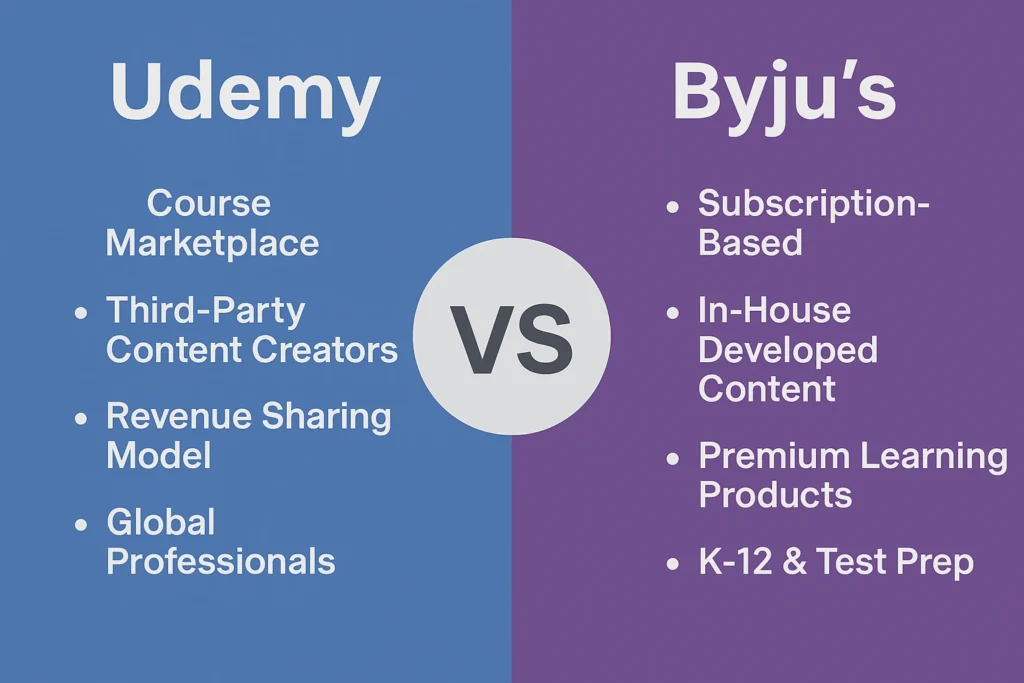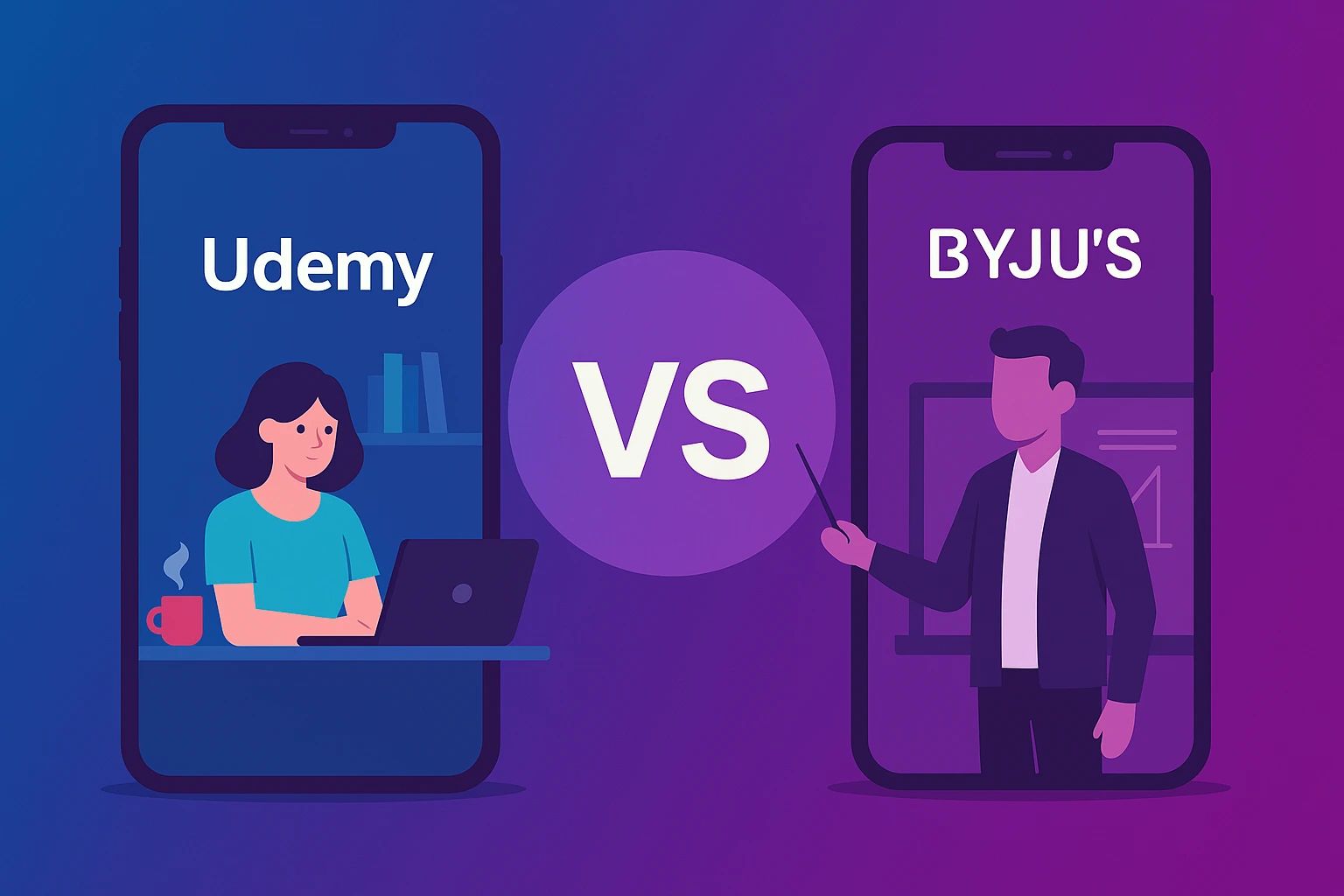The global EdTech industry is booming, with projections estimating it will surpass $400 billion by 2030. In this competitive landscape, two giants—Udemy and Byju’s—have carved distinct paths to success.
But here’s the question startup founders are asking in 2025:
Should you build a platform like Udemy (marketplace-driven) or Byju’s (content + coaching hybrid)?
Choosing the right business model is crucial for EdTech startup sustainability. Each platform offers contrasting strategies in:
- Revenue generation
- Content ownership
- Customer acquisition
- Scalability
In this long-form comparison, we’ll break down both platforms’ models, highlight their pros and cons, and help you decide which approach fits your startup goals.
Whether you’re building a Udemy clone focused on user-generated courses or a Byju’s clone with personalized tutoring and high-end production—this guide is your roadmap for 2025 success.

What is Udemy?
Udemy is a global online learning marketplace launched in 2010. It enables anyone to become an instructor, upload video courses, and earn money from student enrollments.
Today, Udemy has:
- Over 210,000 courses
- 75,000+ instructors
- Learners across 190 countries
Udemy democratizes learning by offering affordable, self-paced content across topics like tech, business, lifestyle, and more.
What is Byju’s?
Byju’s, founded in 2011 in India, started as a K-12 and test prep platform and has since evolved into a full-stack EdTech company offering:
- Interactive video lessons
- Personal tutoring
- Test preparation (CAT, NEET, JEE, UPSC)
- Global acquisitions (Osmo, WhiteHat Jr., Epic!)
Byju’s combines high-end production with AI-driven personalization, targeting school students and exam aspirants.
Business Model of Udemy
1. Revenue Streams
- Course Sales: 50% revenue share with instructors on direct sales; 25% on Udemy-driven traffic.
- Udemy Business: Enterprise subscription model for employee upskilling (B2B SaaS).
- Promotions & Affiliate Marketing: Udemy promotes courses in exchange for a larger revenue share.
- Instructor Tools: Paid promotional features and analytics access.
2. Cost Structure
- Platform maintenance (video hosting, cloud)
- Payment gateway fees
- Marketing spend for demand generation
- Customer support
- Instructor acquisition & platform onboarding
3. Key Partners
- Course creators/instructors
- Affiliate marketers
- Enterprises (for Udemy Business)
- Payment platforms (Stripe, PayPal)
- Cloud providers (AWS)
4. Growth Channels
- Marketplace SEO (organic traffic)
- Paid ads (social, Google Ads)
- Affiliate and email marketing
- Partnerships with companies for employee learning
- Localization of content across geographies
Business Model of Byju’s
1. Revenue Streams
- App Subscriptions: For students (K–12) and test prep modules
- Live Classes & Mentoring: Premium packages with human instructors
- Hardware Sales: Tablets preloaded with content
- B2B Licensing: School collaborations and global curriculum exports
- Acquisitions Revenue: Monetization through platforms like WhiteHat Jr., Epic
2. Cost Structure
- High video production & animation costs
- Tutor salaries and operational overhead
- Hardware distribution costs
- Customer acquisition via massive ad spend
- R&D for personalization and gamification
3. Key Partners
- Animation studios & content creators
- Tutors & mentors
- Schools and institutions
- Tech teams for app development
- Hardware vendors
4. Growth Channels
- National TV & Print Ads
- Free trial strategy with counselor follow-up
- Influencer marketing & parent outreach
- Strategic acquisitions (EdTech consolidation)
- Expanding globally via subsidiary brands
Learn More: Byjus App Features Every EdTech Needs
Comparison Table: Udemy vs Byju’s
| Feature | Udemy | Byju’s |
| Core Model | Course marketplace (B2C/B2B) | Premium structured learning (B2C) |
| Content Ownership | Third-party creators | In-house & exclusive |
| Revenue Style | Commission-based | Subscription & high-ticket bundles |
| Target Audience | Adults, professionals | Students (K-12), exam aspirants |
| Scalability | Highly scalable | Resource intensive |
| Tech Stack | Cloud LMS, payment, analytics | AI personalization, content engines |
| Customer Acquisition | SEO, performance marketing | TV ads, direct sales, counselors |
| Capital Requirements | Moderate | High |
Pros & Cons of Udemy’s Business Model
Pros:
- Scalable with minimal content costs
- Revenue-sharing attracts more creators
- Diverse global learner base
- SaaS (Udemy Business) ensures recurring revenue
Cons:
- Content quality can be inconsistent
- Heavy dependence on instructor activity
- Competitive pricing drives margins down
Pros & Cons of Byju’s Business Model
Pros:
- Premium, high-trust educational experience
- High customer lifetime value (LTV)
- Strong brand presence in India
- Personalization increases engagement
Cons:
- High operational and content creation costs
- Heavy capital burn
- Not easily scalable without funding
Market Data: Growth, Revenue & Funding (2025)
Udemy (2025)
- Revenue: $750 million+
- Valuation: ~$3 billion post-IPO
- Growth: 20% YoY, fueled by Udemy Business
- Learners: Over 60 million globally
- Profitable?: Close to breakeven
Byju’s (2025)
- Revenue: $1.2 billion+
- Valuation: ~$11 billion (after correction from $22B peak)
- Growth: 18% YoY, with diversification
- Learners: 150+ million users globally
- Profitable?: Not yet—high burn continues
Which Model is Better for Startups in 2025?
The answer depends on your budget, team strength, and scaling goals.
- Choose Udemy-style if you want a content-light, scalable platform where users generate content.
- Choose Byju’s-style if you aim for high-end production, localized curricula, and deep engagement—but have resources to back it up.
Choose Udemy-Style Model If…
- You want a marketplace for creators
- Your audience is global professionals
- You prefer low operational overhead
Launch Your Own Udemy Clone with Miracuves
Choose Byju’s-Style Model If…
- You target school-going learners or test prep
- You want to control the learning content
- You’re prepared for higher upfront investment
Build Your Own Byju’s Clone with Miracuves
Conclusion
At Miracuves, we understand that every EdTech startup is unique. Whether you’re inspired by Udemy’s marketplace or Byju’s premium tutoring, we build fully customizable EdTech solutions tailored to your business goals.
With cutting-edge tech, scalable architecture, and marketing integration, we’re your partner in building the next big thing in EdTech.
FAQs
1. Which platform has a more scalable business model?
Udemy’s model is more scalable due to user-generated content and fewer operational costs.
2. Which model suits K-12 education startups better?
Byju’s-style model is more aligned with K-12 and test prep due to its structured content and tutoring.
3. Can I mix both models in one app?
Yes, a hybrid model combining a course marketplace with guided learning is possible—and Miracuves can help build it.
4. Is Udemy’s model suitable for regional EdTech?
Yes, especially if you localize the content and onboard regional instructors.
5. Does Miracuves offer white-label solutions?
Absolutely. Miracuves offers scalable, customizable white-label EdTech platforms modeled after both Udemy and Byju’s.








